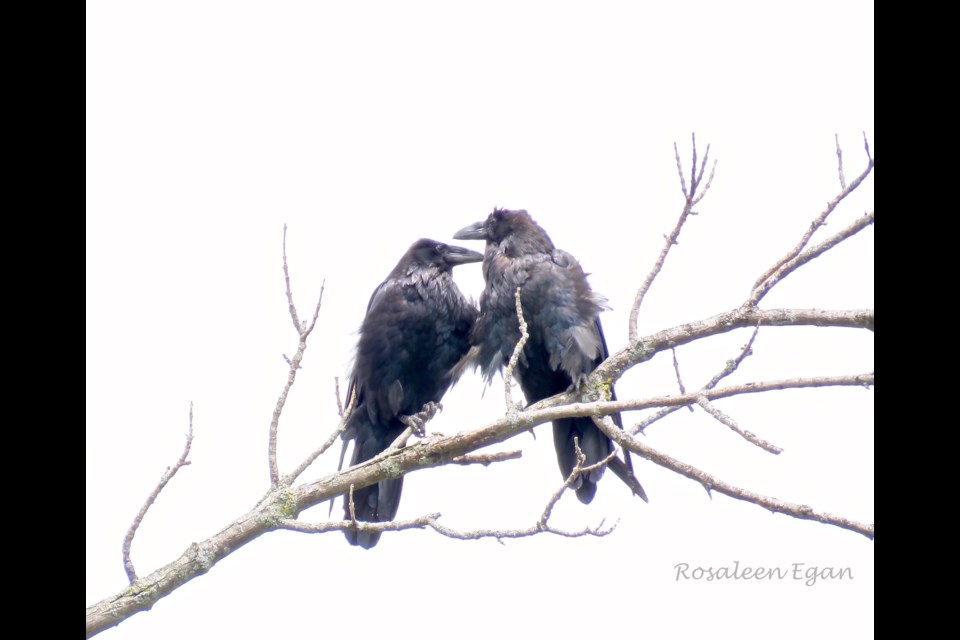I had the privilege of witnessing a very touching display of affection between Common Ravens recently.
I did consider if I was intruding on their private time, but they made quite a croak about their whereabouts. The whereabouts was a tree with no branches, so they didn’t seem to be concerned about being discreet. I admire their openness in sharing their love. Also, it was quite moving in its tenderness, and so the sharing passed on a good feeling.
I first became aware of them when one loudly announced its presence atop a silo. Not long after, a voice answered from the other silo. At some point, they joined each other in a nearby tree. They were gurgling and croaking to each other. A neighbour said look at the crows. He went by the similarity in appearance to crows, yet the sound truly declared them as ravens.
The American Crow has a high-pitched caw whereas the Common Raven has guttural sounds. Crows have a wingspan of about 75 cm compared to up to 1.5-metre span of ravens. A crow’s tail is blunt and fan-shaped. Ravens have longer feathers in the centre that come to a point, creating a wedge shape. Crows’ bills are narrower than ravens and they don’t have the neck feathers (hackles) that stand up as ravens do.
According to birdsoftheworld.org a raven tends “to soar and glide rather than flap its wings continually in flight; wings appear longer and more tapered toward tip (“hand”)”. The site adds ravens tend “to be found solitary or in pairs more often than other Corvus, but in many areas seen foraging or roosting in flocks or groups of several hundred to several thousand individuals”.
“This large, black, majestic bird is geographically and ecologically one of the most widespread naturally occurring birds in the world. It is distributed throughout major portions of North America, Europe, Asia, and North Africa, and in all terrestrial biomes except tropical rain forests,” states birdsoftheworld.org.
The raven population in North America has increased since 1966 as forests in north-eastern areas are regenerating after being cleared for farming in the 19th and early 20th century.
The love duo I witnessed are likely mates for life, but studies about raven's commitment to one another are not extensive. Mated pairs do claim a territory and spend up to nine days building a nest that can be 1.5 metres wide and just over half a metre high.
Ravens are known for their intelligence in solving problems, learning through observation, tricking other animals, examining discovered objects and finding uses for them. What fascinated me about my encounter with these two lovebirds was their deference to each other and the stillness in the encounter.
It was remarkable to witness this exchange. It was also affirming to later read that others have recorded what I observed. Birdsoftheworld.org says a raven solicits “preening by holding still and bowing head to be preened on back of head, or holding head back to be preened on throat. Birds often also hold each other's partly open bill and sometimes each other's foot”.
Poet Edgar Allan Poe and others have shadowed the raven with a dark interpretation. Ravens can be pests and predators as well as scavengers. Some North American indigenous peoples attribute them as the creator of the earth, moon, sun and stars while also seeing them as tricksters.
I am grateful I was able to see a soft side of this fascinating bird.
I share experiences of bird visitors to this property with readers every couple of weeks. Until next time, keep your eye to the sky, and look for birds that may come by.
Raven sounds: https://www.allaboutbirds.org/guide/Common_Raven/sounds
Crow sounds: https://www.allaboutbirds.org/guide/Common_Raven/sounds
Rosaleen Egan is a freelance journalist, a storyteller, and a playwright. She blogs on her website rosiewrites.com








